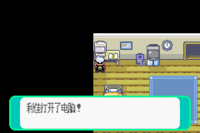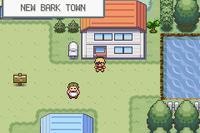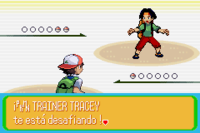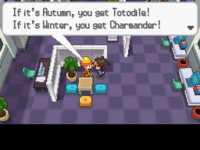ROM hack: Difference between revisions
m (→Game types: readability tweaks) |
m (→Pokémon Naranja/Orange: added missed words) |
||
| Line 71: | Line 71: | ||
===Pokémon Naranja/Orange=== | ===Pokémon Naranja/Orange=== | ||
[[File:Pokémon Naranja.png|left|thumb|200px|Battling [[Tracey (anime)|Tracey Sketchit]] in Pokémon Naranja]] | [[File:Pokémon Naranja.png|left|thumb|200px|Battling [[Tracey (anime)|Tracey Sketchit]] in Pokémon Naranja]] | ||
"Pokémon Naranja" is a {{wp|Spanish}} hack of {{game3|Ruby and Sapphire|Pokémon Ruby|s}} in which the {{player}} plays as either {{Ash}} or [[Misty]] and travels around the [[Orange Archipelago]]. Naranja is a Spanish word which means "{{tt|orange|in reference to the fruit, not the colour}}". {{p|Celebi}} appears this game's [[version mascot]]. This game is based on the [[Pokémon: Adventures in the Orange Islands|Orange Saga]] in the {{pkmn|anime}}. The game starts after the player had won the [[Indigo League]]. Despite this fact, the player starts with only a Lv. 5 {{p|Pikachu}}. Many characters, plots and events in the Orange Saga are included in the game, such as the [[GS Ball]], Ash's {{AP|Lapras}}, the [[Orange Crew]], the [[Crystal Onix]], the {{p|Golduck}} from ''[[EP091|Bye Bye Psyduck]]'', and [[Ash's Snorlax]]. This game particularly well-polished and features a completely overhauled graphical system, and well as many hours of playtime. Other anime-based hacks include the popular Pokémon AshGray, a FireRed-based game depicting Ash's journey through the [[Kanto]] region in the [[original series]]. | "Pokémon Naranja" is a {{wp|Spanish}} hack of {{game3|Ruby and Sapphire|Pokémon Ruby|s}} in which the {{player}} plays as either {{Ash}} or [[Misty]] and travels around the [[Orange Archipelago]]. Naranja is a Spanish word which means "{{tt|orange|in reference to the fruit, not the colour}}". {{p|Celebi}} appears as this game's [[version mascot]]. This game is based on the [[Pokémon: Adventures in the Orange Islands|Orange Saga]] in the {{pkmn|anime}}. The game starts after the player had won the [[Indigo League]]. Despite this fact, the player starts with only a Lv. 5 {{p|Pikachu}}. Many characters, plots and events in the Orange Saga are included in the game, such as the [[GS Ball]], Ash's {{AP|Lapras}}, the [[Orange Crew]], the [[Crystal Onix]], the {{p|Golduck}} from ''[[EP091|Bye Bye Psyduck]]'', and [[Ash's Snorlax]]. This game is particularly well-polished and features a completely overhauled graphical system, and well as many hours of playtime. Other anime-based hacks include the popular Pokémon AshGray, a FireRed-based game depicting Ash's journey through the [[Kanto]] region in the [[original series]]. | ||
==Non-core series hacks== | ==Non-core series hacks== | ||
Revision as of 03:39, 21 March 2015
ROM hacks, also known as hack games or ROM patches, are video games that have been edited or altered by enthusiasts. The hackers achieve this by changing the code of the Read-Only Memory of a published video game to create something new.
The core series Pokémon game system is considered very versatile and lends itself well to modification, giving hackers a lot of creative freedom together with a solid, well-tested game engine. These factors, as well as Pokémon’s notable popularity throughout the world, has lead to the creation of thousands of different games spanning multiple generations, ranging from minor adjustments to additional new features and, more and more frequently, entirely new fan-made Pokémon games.
There is a distinction between ROM hacks and "bootleg games". These are unauthorised copies of published games which are sold to consumers, often flashed onto after-market game paks or game cards and lacking the official Nintendo Seal. However, since ROM hacks are often distributed over the Internet for free, they are regularly sold as bootleg games, usually against the hacker’s wishes. The reliability of these bootlegs are often poor, and has become such a problem that hackers have started to introduce warning screens into their games, cautioning users that if they paid for it, they may have been scammed.
History
Early Pokémon ROM hacks date back to the late 1990s with modified editions of Pokémon Red. These were often relatively minor adjustments such as sprite or dialogue changes, and would generally follow the flow of the original game. These early ROM hacks were infamous for being particularly crude in nature, ranging from swapping Pokémon and human sprites around to replacing the dialogue with obscene text.
This trend continued until the release of Pokémon Brown by user Koolboyman in the early 2000s, one of the most notable Pokémon hacks in history. This was the first hack to completely re-invent the game, with a brand new region and completely new plot. Later editions included an expanded Pokédex (including Pokémon from Generations II, III and IV), additional dungeons and additional plot tweaks. It is one of the few completed hack games and was successful enough to warrant a sequel (Pokémon Prism, a Pokémon Gold-based hack) and a Generation III version (Pokémon rijonAdventures) based on Pokémon FireRed.
Since Brown, Pokémon hacking’s notoriety has expanded exponentially, with developers creating many software tools for desktop operating systems to help create maps, edit sprites, graphics and even developing scripting languages specifically for the Pokémon game engine. It has also inspired many hackers to learn how to edit the games' assembly code directly (known as ASM hacking). Numerous hacks have been released, often using FireRed as a base, such as Pokémon ShinyGold, Pokémon Naranja and the Pokémon Ruby Destiny series, just to name a few.
There are many websites dedicated to Pokémon ROM hack development. Notable examples include Skeetendo, PHO and PokéCommunity’s ROM Hack section, the largest known English-language Pokémon ROM hacking community. Many of these sites hold award nominations and ceremonies to showcase some of the best talents of their community.
Legality
As suggested by it’s name, read-only memory is designed only to be read and not modified in any way. Most published games belong to their respective publishers, hence the read-only memory portion of these games are subject to intellectual property and copyright laws. It is illegal in most countries to make copies of or redistribute any of the game’s code. As a result, it is illegal to distribute copyrighted ROM files in any way, including over the Internet. Doing so may result in prosecution on the grounds of copyright law.
This issue is dealt with by hackers distributing what are known as patch files. Essentially, these are small sets of computer instructions on how to modify a ROM file in a particular way, which produces the hacked game. Patch files, often distributed in the IPS or UPS format, are not illegal and can be distributed freely. However, one would need to obtain the required ROM file and patching software in order to apply the patch.
Game types
Pokémon ROM hacks tend to fall into five vague categories, though due to the huge versatility of the Pokémon engine, some hacks will transcend several categories at once.
151/386/649 or Dex hacks
These hacks, such as Pokémon Red 151, Pokémon Emerald 386 and Pokémon BlazeBlack/VoltWhite are designed to make available all Pokémon, items and locations within the game, including event Pokémon, version-exclusive Pokémon, Pokémon only obtainable through trading, Event Locations and Event Items. These will often not deviate too far from the official game story, and are often used in Nuzlocke runs and, more notably, for several episodes of Twitch Plays Pokémon.
Hard Mode hacks
These hacks, such as Pokémon FireRed: The Hard Version and Pokémon Expert Emerald, also differ little from official game in terms of story. They instead have a significantly higher difficulty than usually experienced in regular Pokémon games. These types of games too are popular amongst Nuzlockers as an additional challenge on top of Nuzlocke rules. Many fans see Pokémon Black and White 2’s Challenge Mode as an acknowledgement of these hacks, though no official link has been made.
ROM bases
These hacks are often designed to be used as a base for other ROM hacks, and often include major revisions to the game’s base code through ASM hacking to add new features such as additional types or a completely re-vamped tileset. Notable features include the introduction of genders into Pokémon Gold, the addition of a Physical/Special split and the real-time clock into Pokémon FireRed, which gives way to a full Day/Night system, a feature that was missed by many fans in Generation III.
Another noteworthy feature is the development of the UPS format, which allows the expansion of GameBoy Advance ROM hacks from their original 16MB format to 32MB. This has the advantage of effectively doubling the space available for new maps and graphics, but means the game is only playable under emulation and will crash when played on official Nintendo hardware.
Language hacks

Since the core series games prior to Generation VI were regularly released first in Japan, sometimes months ahead of their international releases, amateur enthusiasts would often translate Japanese-language Pokémon games into English and other languages so they could be played by international audiences. Since the translation was often performed by one or a small group of people, the quality of these translations were often dubious to say the least, the most humorous example being Pokémon Vietnamese Crystal. Nonetheless, these hacks were generally translated well enough to be played and were very popular amongst YouTubers.
In recent years, the core series games have begun releasing simultaneously around the world in more languages and as a result the need for language hacks has somewhat diminished. It does still happen for languages that the Pokémon games are not yet available in, most notably Chinese.
Full/complete hacks
These hacks are complete overhauls of the games, with new characters, plots, regions and features. They often overhaul the game’s graphics, incorporating those seen in later generation games including battle backgrounds, sprites and map tiles. They will regularly include Pokémon, moves and types from later generations, and will sometimes include brand new ones created by the hacker. Some hacks, such as ShinyGold and LiquidCrystal, are remakes of entire previously-released games, in the same way that FireRed and LeafGreen were remakes of Red, Blue and Yellow.
Because of the extraordinary amount of work involved by a voluntary hacker or hacking team, few of these games are finished in their entirety and are usually playable in the form of a beta. Most of the notable hacks below are considered to be part of this category.
Notable core series hacks
With the release of easy-to-use hacking tools for the core series games, there are thousands of ROM Hacks available. What follows is a few notable examples, each with a brief explanation.
Pokémon ShinyGold

"Pokémon ShinyGold" was a Generation III remake of Gold and Silver using the Pokémon FireRed engine, echoing how FireRed is a remake of Pokémon Red. Whilst not the first of its kind it is amongst the most well-know Generation III hacks, and despite it never leaving beta is still one of the most popular. It is also one of the most illegally sold ROM hacks, with many bootleg versions of ShinyGold available as pre-patched ROMs or flashed game paks. ShinyGold's creator, username Zel, included a warning in later editions warning users about this problem and to demand their money back if they had paid for it.
ShinyGold is one of a number of Generation II remakes developed by hackers. Other examples include Pokémon LiquidCrystal and Pokémon CrystalDust, both of which include expanded areas and features, amongst others.
Pokémon Ruby Destiny Series

"Pokémon Ruby Destiny" is a popular series of games based on the Pokémon Ruby engine created by PokéCommunity user destinedJaGold. The series consists of three completed games: Reign of Legends, Rescue Rangers and Life of Guardians. A fourth, Broken Timeline, is currently under development. This series is of particular note, as it is one of the longest running completed hack series available, partiularly for it's in-depth gameplay and plot. It, like other popular hacks, has even drawn interest from Let's Play creators. The series is also know for incorporating the Fairy type into the Generation III game engine, as well as a user-created "Chaos type", alongside several user-created Pokémon (known as "Fakémon" among fans).
Moemon
"Moemon" (short for "Moekko Monsters") is a prominent hack of Pokémon FireRed that changes all Pokémon into gijinka. It is a simple change of FireRed, but with additions such as the ability to catch the three starters, Eevee, and a mix of both LeafGreen and FireRed Pokémon (thus making it simpler to obtain all Pokémon). The game still receives a fair amount of attention, as a patch was released solely for the FireRed hack that updated both the sprites of the Pokémon as well as their menu sprites, functioning like DLC would for any game.
A ROM hack of Emerald has been released as well. Like the FireRed hack, it's a simple change of Emerald, replacing all Pokémon with ginjika counterparts, however, a few aesthetic changes have been applied to both Route 101 and Littleroot Town, adding many puddles to the town, and the Oran Berry has, curiously, been renamed the "Weed Berry", possibly for comedic effect.
Moemon received a short burst of fame when gaming site Kotaku posted an article about it in late 2007.[1]
Pokémon Naranja/Orange

"Pokémon Naranja" is a Spanish hack of Pokémon Ruby in which the player plays as either Ash or Misty and travels around the Orange Archipelago. Naranja is a Spanish word which means "orange". Celebi appears as this game's version mascot. This game is based on the Orange Saga in the anime. The game starts after the player had won the Indigo League. Despite this fact, the player starts with only a Lv. 5 Pikachu. Many characters, plots and events in the Orange Saga are included in the game, such as the GS Ball, Ash's Lapras, the Orange Crew, the Crystal Onix, the Golduck from Bye Bye Psyduck, and Ash's Snorlax. This game is particularly well-polished and features a completely overhauled graphical system, and well as many hours of playtime. Other anime-based hacks include the popular Pokémon AshGray, a FireRed-based game depicting Ash's journey through the Kanto region in the original series.
Non-core series hacks
Though the core-series is by far the most popular series to hack, there are also many fan-created Pokémon games that do not use these as basis. These include "Pokémon Adventure", a hack of Sonic Adventure 7 for the GameBoy Color and "Pokémon 4-in-1", a hacked game for the NES comprising of several mini games. There are also examples of modified versions of the Pokémon Mystery Dungeon series and Pokémon Conquest.
Bootleg games

|
The contents of this article have been suggested to be split into Bootleg games. Please discuss it on the talk page for this article. |
Whilst technically-speaking these are modifications of published games, the ROM hacking community generally considers these more as "bootlegs" rather than ROM hacks. The main difference being these games were likely designed to trick players into thinking they were official for monetary gain, something which most ROM hackers actively try and avoid. These games were often flashed to third party game paks and sold illegally. Below are some notable examples.
Pokémon Diamond and Jade
Possibly the most well-known bootleg "Pokémon" games are the notorious Pokémon Diamond and Jade (not to be confused with the official Generation IV games Pokémon Diamond and Pearl). These games are knock-off versions of the Power and Speed Versions of Keitai Denjū Telefang, respectively, which were only released in Japan for the Game Boy Color on November 2000, a year after Pokémon Gold and Silver and a month prior to Pokémon Crystal.
Pokémon Jade is sometimes found on the same cartridge as an illegally produced Pokémon Crystal cartridge but could also be found as a standalone cartridge. It was also mentioned in the Pokémon.com mailbag in 2003 as "the bootleg and illegally produced Pokémon Jade".
These bootlegs had numerous glitches that the real games did not have, such as the inability to load a save file properly. The game also contains broken English, profanity, and swearing, which is absent from all official Pokémon games licensed by Nintendo, with the British Gaming Blog describing the additions as "a healthy dose of Engrish and plenty of swear words."[2]
The real Telefang games do share conceptual similarities with the real Pokémon games. Whereas in the core series Pokémon games, players take the role of a Pokémon Trainer who travels through a specific region of the Pokémon world to obtain or catch Pokémon in Poké Balls and send them out for battles, in the Telefang games, players take the role of a T-Fanger who travels through the Denjū World to befriend creatures called Denjū and have them battle each other using a device called the D-Shot. However, unlike Pokémon, Denjū themselves have a D-Shot and call each other to battle. Other similarities between the two game series can be seen in the mechanics of each: the creatures in both share common stats such as HP, Attack, Defense, and Speed; both series have moves or attacks in common, like どくばり (Pokémon, Telefang), とっしん (Pokémon, Telefang), かえんほうしゃ/カエンホウシャ (Pokémon, Telefang), or じしん (Pokémon, Telefang), and both series also have natures for their creatures (Pokémon, Telefang), though the effects of moves are not necessarily the same in every case, and natures work differently.
Pokémon Diamond 2 and Jade 2
Similar to the first fake Diamond and Jade games, Diamond 2 and Jade 2 were hacked from Keitai Denjū Telefang 2. Also, like Diamond and Jade, the Power Version of Telefang 2 became Pokémon Diamond 2, and the Speed Version became Pokémon Jade 2. They are in Chinese, and their title screens have been altered to poorly drawn Pokémon characters along with the character Dragon from the film Shrek (possibly due to her superficial similarity to a Charizard). The similarities between the title screens of this and the original Diamond and Jade (as well as the fact that they have Pokémon names in the first place) suggest that these may be made by the same people. Diamond 2 crashes after the title screen, making it unplayable without a save state, and Jade 2 has graphical glitches. There is also a poorly translated English version of the Power Version of Telefang 2 called "Pokémon Ruby," which has no relation to the real one.
Pokémon Vietnamese Crystal

"Pocket Monsters Crystal Version" (popularly known as Pokémon Vietnamese Crystal) is a bootlegged version of Pokémon Crystal. Translated from Japanese to Chinese to English, the dialogue in the game (now Engrish) is often nonsensical and unintentionally humorous. All Pokémon, character and location names are similarly badly translated, often resembling romanizations of Chinese transliterations of the Japanese names. The translations is noted as being so poor that the game achieved a cult status, and is the subject of many popular Internet memes. It was made popular by various "Let's Play" video series on YouTube, with the most notable one being by DeliciousCinnamon.
External links
- Wikifang - A wiki about Telefang, the game that became Pokémon Jade and Diamond (includes information on the fakes)
References

|
This article is a part of Project Fandom, a Bulbapedia Project that aims to write comprehensive articles on every aspect of the Pokémon Fandom. |





